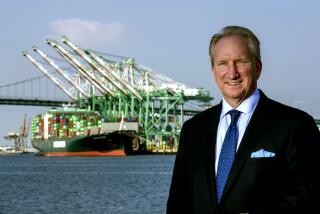There’s This Teensy-Weensy Matter About Port Fees . . .
- Share via
If you’re contemplating a cruise, you’ve probably already got a lot to think about, from itineraries to prices to sorting out the hundred-odd ships out there and the two dozen more expected to debut in the next four years. But here’s something that might not be on your checklist: The industry is in the middle of an uncomfortable and untidy transition in the way it bills passengers, and at the heart of the trouble is the issue of port fees.
Many passengers have long presumed that port fees are merely a pass-along of various taxes and government levies that ports require cruise lines and their passengers to pay when they come to dock. It’s long been the cruise industry’s custom to exclude those fees (anywhere from $80 to $200, depending on the itinerary) from the fare figure advertised in large print by cruise lines.
But over the last several years, consumer advocates noticed port fees inflating, with many cruise lines adding various sorts of other nongovernment expenses in with those taxes, including such items as payroll expenses, tugboat fees and phone bills. That practice allowed the cruise lines to keep their advertised fares down--a useful strategy in a crowded, highly competitive marketplace--and make up for it by boosting their port fees. In the case of some three-day Mexican itineraries, cruises carried a fare of $249, but the port fees added $84.50 to that--a boost of more than 30%.
Not surprisingly, such practices drew complaints from consumer advocates. Last year, the Florida Attorney General’s office launched an investigation of the practice, and the upshot in February 1997 was a settlement with six of the targeted cruise lines. Under the settlement, those lines (Carnival Cruise Lines, Royal Caribbean Cruises Ltd., Norwegian Cruise Lines Ltd., Celebrity Cruises Inc., Dolphin Cruise Line and Majesty Cruise Line) agreed to pay a combined $295,500, and pledged not to add any fees to their advertised initial ticket prices except specific charges from governmental and quasi-governmental agencies. (Los Angeles-based Princess Cruises, also named in a lawsuit by the Florida Attorney General, struck a separate settlement with an $85,000 payment in April.)
Rather than restrict their working definition of “port fees,” many cruise companies took the Florida agreement as a cue to drop that separate charge from their ads altogether, and incorporate it into a single fare price. But from there, it gets complicated.
Cunard does it one way, Norwegian Cruise Line does it another, Carnival has done it yet another. And the confusion doesn’t end with the cruise lines.
Despite the decision of many cruise companies to consolidate the port charges into their overall advertised fares, some travel agencies are still buying ads to promote those companies’ cruises and subtracting the port fees in the same old way that raised objections in the first place. Thus the same fare could end up advertised with two different numbers in large print. Cruise company representatives acknowledge that this could cause confusion, but claim they can’t control agency ads.
Here’s a sampling of the policies among some cruise lines:
At Carnival Cruise Lines, says spokesman Tim Gallagher, all national advertising since June has bundled port fees into one overall price. But the company’s phone reservationists also have other numbers. Though an ad may quote a cruise price of $700, Gallagher says, the company’s reservationists are still instructed to call it a $600 cruise with $100 in port fees. Why? Apparently because Carnival wants travel agents to understand that, like other cruise companies, it intends to continue basing its commission payments to agents on the old lower fare figures, not the higher price that includes the port costs.
Cunard Line continues to set “port and handling charges” apart. William J.H. Spears, the line’s senior vice president for communications, notes that those fees include various types of port-related overhead in addition to government fees, but remain a small portion of the overall price.
At Holland America, public relations director Larry Dessler says that since June, the company’s advertising and brochures have gone out with a single price.
At Norwegian Cruise Line, says spokeswoman Fran Sevcik, all new brochures quote a single price, and all Florida advertising quotes a single price. But in all advertising outside Florida, prices remain unbundled until this fall, when the line plans to switch over all its prices to a bundled policy.
At Princess Cruises, nationwide ads since June 1 have included nongovernmental port fees in cruise fares since June 1. Government fees are kept separate. For example, on a seven-day Caribbean cruise with a bottom-end fare of $827, passengers also pay $81 in government fees and taxes.
Reynolds travels anonymously at the newspaper’s expense, accepting no special discounts or subsidized trips. He welcomes comments and suggestions, but cannot respond individually to letters and calls. Write Travel Insider, Los Angeles Times, Times Mirror Square, Los Angeles 90053 or e-mail [email protected].
More to Read
Sign up for The Wild
We’ll help you find the best places to hike, bike and run, as well as the perfect silent spots for meditation and yoga.
You may occasionally receive promotional content from the Los Angeles Times.







